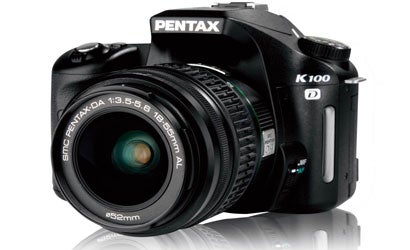Hands On: Pentax K100D
Shake reduction and not-quite-live preview.

We may earn revenue from the products available on this page and participate in affiliate programs. Learn more ›
Image stabilization has become the hot feature to have on a camera, whether it’s a pocket point-and-shoot or a DSLR. And now Pentax has joined in with the K100D ($699 estimated retail, with 18-55mm f/3.5-5.6 Pentax DA lens), an easy-handling 6-megapixel digital SLR that achieves image stabilization by using a moving CCD sensor.
If you think that sounds similar to the Anti-Shake system on a Konica Minolta DSLR, you’re right, although Pentax states that its Shake Reduction is “our proprietary technology,” and not licensed from KM. The system will work with any Pentax DA lenses and is projected to work with all of the Pentax 35mm system lenses (there are some 24 million out there, according to Pentax).
We had only a preproduction K100D in our hands for a few days, so we couldn’t test the system in the Pop Photo Lab, but by the time you read this we should have Certified Test Results posted on www.PopPhoto.com.
In appearance, the K100D is very nearly a clone of the Pentax *ist DS2; aside from the image stabilization on/off switch on the back of the camera, only slight differences in body contours and button shapes set the new camera apart from the DS/DL series. The body weighs less than an ounce more than the *ist DS2.
Functionally, the K100D borrows from both the *ist DS2 and the *ist DL2 (not marketed in the U.S. as a Pentax, but available as the Samsung GX-1L). From the DS2, the new camera gets the 11-zone autofocus array. From the DL2, the K100D inherits a cost-cutting penta- mirror rather than a glass pentaprism, as well as a feature called Digital Preview.
When triggered by the depth-of-field preview switch, this takes a shot, stores it to the internal buffer, and displays it immediately on the LCD. The camera will hold the image in the buffer for 60 seconds or until you touch the shutter button again.
Now, you may ask, why not just take a picture and preview that? Well, Digital Preview does save you space on your memory card-but then, you can always erase a picture from a memory card. Kind of gimmicky, we say. And you can always program the depth-of-field control (via custom function) to stop down the lens to the shooting aperture for conventional depth-of-field preview.
The eagle-eyed may spot another subtle difference on the topside mode dial. Instead of just a basic all-auto mode, you’ll find a scene-mode position, where you can choose, via the menus, from an additional eight scene or subject modes, besides the five already on the dial. The new ones are Night Scene, Surf and Snow, Text, Sunset, Kids (which promotes “healthy and bright skin tone”), Pets, Candlelight, and Museum.
While the K100D uses a 6MP CCD like the *ist DSLRs, Pentax says that the processing engine and firmware are new, and that the camera will ship with improved software.
Still, we were more than a little surprised that Pentax didn’t opt to move up to 8MP or 10MP capture with the new camera; 6MP DSLRs are getting very old at this point. The company was clearly determined to hew hard to a low price point with the K100D, and it certainly succeeded. For the even more frugal, a K110D-the same camera but without Shake Reduction-will be available for $599 with the kit lens.